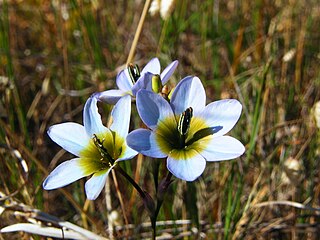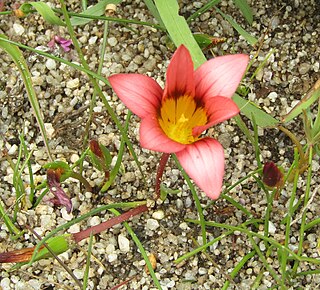
Agapanthus africanus, or the African lily, is a flowering plant from the genus Agapanthus found only on rocky sandstone slopes of the winter rainfall fynbos from the Cape Peninsula to Swellendam. It is also known as the lily-of-the-Nile in spite of only occurring in South Africa.

Disa bracteata, also known as the bract disa, leek orchid or the South African weed orchid is a species of orchid native to South Africa.

Moraea aristata is a species of flowering plant in the family Iridaceae. It is referred to by the common names blue-eyed uintjie or Blouooguintjie in Afrikaans.It is endemic to the city of Cape Town and is considered to be critically endangered.

Baeometra is a genus in the family Colchicaceae containing a single species, Baeometra uniflora. It is native to South Africa, where it is commonly called beetle lily due to the dark markings on the tepals.

Gladiolus alatus is a species of geophyte from South Africa. Common names include painted ladies, king kalkoentjie and kipkippie. Kalkoentjie means "little turkey" in Afrikaans and refers to the shape of the flower, which resembles a turkey's wattle. It is popular as a garden plant and an important part of the cut flower industry in parts of the world on account of its large and showy orange flowers.

Ixia monadelpha, also known as the pied kalossie or bontkalossie, is an endangered species of geophyte found in wet sandy flats in the southwestern Cape of South Africa.

Geissorhiza radians or winecup flower is a highly threatened species from the Iris family with fewer than 10 remaining sub-populations growing in south-western Cape Town, South Africa. The deep purple flowers with large, red centres grow is dense colonies which makes for a spectacular flower displays from mid-September, particularly around the town of Darling. Its seasonally wet lowlands habitat is however becoming increasingly threatened with more than 80% of its original habitat now permanently transformed into agriculture or urban sprawl and the remaining populations threatened by encroaching invasive alien vegetation and fertilizer runoff. The dark-centred flowers aim to attract specific pollinators from the horsefly family (Tabanidae), but the specific interactions still require additional investigation. Each plant has 1 to 6 flowers. It is also found in smaller patches through to Gordon's Bay. The plants nearly always occur in seasonally moist wetlands which become dry in the summer months.

Geissorhiza melanthera is a small perennial plant of 14–18 cm high that is assigned to the family Iridaceae. It survives the dry southern summer through storage of its resources in a corm. The stem carries two or three erect, sticky leaves of up to 18 cm (7 in) long, H-shaped in cross-section. This species blooms with six to twelve bilaterally symmetrical flowers, in a spike. Sometimes the spike has one side branch with fewer flowers. Each flower has six pale beige perianth lobes, a purple-red ring around a purple red tube and three blackish stamens. Each flower is subtended by two 1.25–2.25 cm long green bracts. This species flowers from the end of September till mid October. It is an endemic of the western slopes of the Piketberg mountains in the Western Cape province of South Africa.

Romulea monadelpha is a herbaceous perennial geophyte in the family Iridaceae native to South Africa. It has a small corm in the soil, a few thread-like leaves, and trimerous dark red flowers with elaborate markings on the inside near the bottom of the flower. It is called karoo satynblom in Afrikaans.

Cyrtanthus ventricosus, commonly called fire lily, is a small deciduous, bulbous plant reaching a height of 100–250 mm (3.9–9.8 in). It is in the amaryllis family, Amaryllidaceae, and is found along the Cape Fold Mountains from the Cape Peninsula, Western Cape, to the Kouga Mountains, Eastern Cape in South Africa.

Wahlenbergia capensis, commonly known as the Cape bluebell, is a plant in the family Campanulaceae and is native to the Cape Province but has been introduced to Australia. It is an annual herb with up to four greenish blue, bell-shaped flowers with spreading petal lobes.

Babiana villosa is a species of geophyte of 10–20 cm (3.9–7.9 in) high that is assigned to the family Iridaceae. It has mauve-pink, purple or scarlet star-symmetrical wide chalice-shaped flowers with narrow tube, large, blackish or dark purple anthers, and velvety hairy, lance-shaped, laterally compressed leaves, set in a fan. Flowers occur during August and September. It grows between Malmesbury and Wellington in the Western Cape province of South Africa. It is commonly called red babiana in English and rooibobbejaantjie in Afrikaans.

Babiana dregei is a species of geophyte in the genus Babiana. It is endemic to the Northern Cape of South Africa, including Namaqualand.

Cyphia bulbosa, also known by its common name Bulb Baroe, is a species of flowering plant from the genus Cyphia.
Isoetes stellenbossiensis, the Stellenbosch quillwort or Cape Flats quillwort, is a species of plant from South Africa.
Cheiridopsis umdausensis is a species of succulent plant from South Africa.

Geissorhiza splendidissima, the blue pride-of-Nieuwoudtville, is a plant species of geophyte in the family Iridaceae. It is endemic to Nieuwoudtville in the Northern Cape of South Africa. It is also called the Bokkeveld pride and splendid satin.

Romulea hirsuta is a geophyte from South Africa. It has pink flowers with dark marks at the edges of the yellow center.

Lachenalia unifolia, the banded viooltjie, is the most common Lachenalia species in the Cape Floristic Region of South Africa.
Lachenalia variegata, also known as the spotty viooltjie, is a species of plant from the Western Cape of South Africa.

















